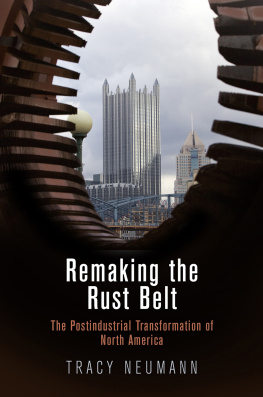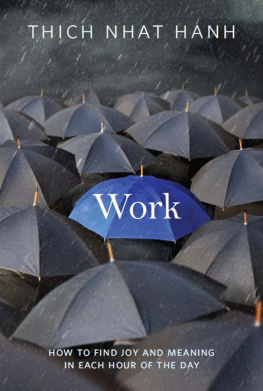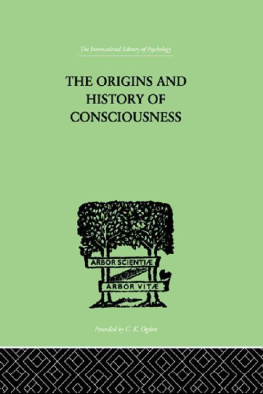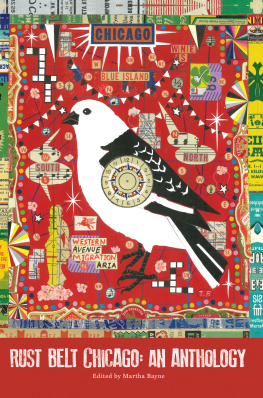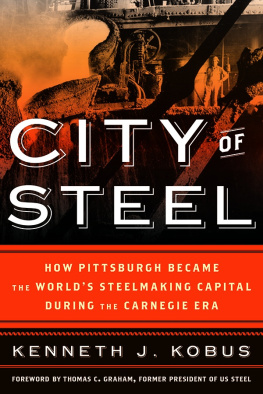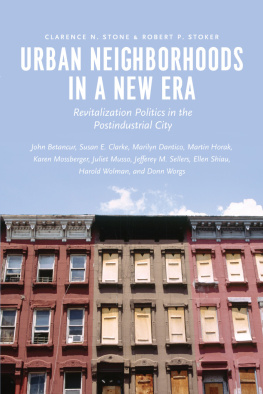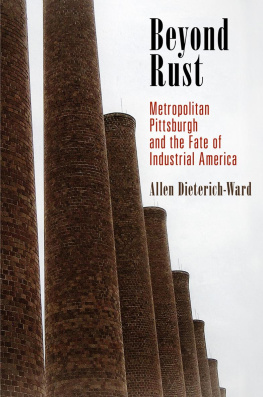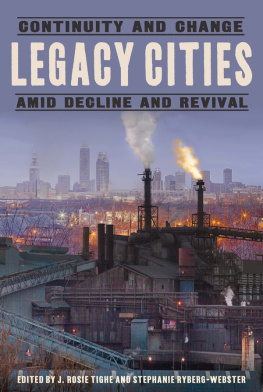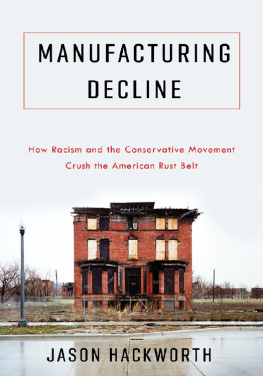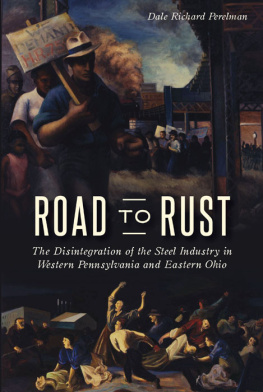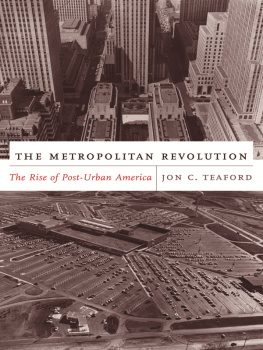Contents
Page List
Guide

Remaking the Rust Belt
AMERICAN BUSINESS, POLITICS, AND SOCIETY
Series editors:
Andrew Wender Cohen, Pamela Walker Laird,
Mark H. Rose, and Elizabeth Tandy Shermer
Books in the series American Business, Politics, and Society explore the relationships over time between governmental institutions and the creation and performance of markets, firms, and industries large and small. The central theme of this series is that politics, law, and public policyunderstood broadly to embrace not only lawmaking but also the structuring presence of governmental institutionshas been fundamental to the evolution of American business from the colonial era to the present. The series aims to explore, in particular, developments that have enduring consequences.
A complete list of books in the series is available from the publisher.
Remaking the Rust Belt

The Postindustrial Transformation of North America
Tracy Neumann

UNIVERSITY OF PENNSYLVANIA PRESS
PHILADELPHIA
Copyright 2016 University of Pennsylvania Press
All rights reserved.
Except for brief quotations used for purposes of review or scholarly citation, none of this book may be reproduced in any form by any means without written permission from the publisher.
Published by
University of Pennsylvania Press
Philadelphia, Pennsylvania 19104-4112
www.upenn.edu/pennpress
Printed in the United States of America on acid-free paper
1 3 5 7 9 10 8 6 4 2
Library of Congress Cataloging-in-Publication Data
ISBN 978-0-8122-4827-2
CONTENTS

INTRODUCTION

Cities and the Postindustrial Imagination
In 1968, shortly after Jack Moore became Hamilton, Ontarios, first economic development commissioner, he took a trip to Pennsylvania. Concerned about industrial decentralization, suburban migration, and central city decline, Hamiltons municipal officials had replaced the citys Industrial Development Commission with an Economic Development Commission and initiated a series of urban renewal projects intended to reinvent their drab steel town as a bustling regional service center. Pittsburgh, Hamiltons steel-producing neighbor to the south, offered them a successful model, and Moore went down to investigate. Hiram Milton, president of Pittsburghs Regional Industrial Development Corporation, and John J. Grove, executive director of the Allegheny Conference on Community Development, took Moore on a tour of the citys redevelopment sites. But Moore was more interested in learning the details of how the corporate-led Allegheny Conference had worked with public officials to turn the citys smoke-filled downtown into a modern commercial center. My principal reason for visiting Pittsburgh, he had written to Grove when arranging his trip, is not just to look at industrial development but to learn a good deal more about how your organization was successful in spearheading the redevelopment of downtown Pittsburgh. I am particularly interested in knowing how you can demand and get active participation from your top business executives.
For Moore and the city officials he represented, reproducing Pittsburghs public-private partnership looked like the best route to making Hamilton something more than a steel town. Public officials in other manufacturing centers had the same idea. In the 1950s and 1960s, more than seventy national and international delegations of urban policy tourists who hoped to replicate the Renaissance, as the citys urban renewal program was known, arrived in Pittsburgh to see first-hand how Democratic mayors and Republican businessmen had worked together to scrub clean the streets and skies of the dirty, polluted, and flood-prone city. Visitors from Dayton and Detroit wanted to know more about Pittsburghs urban renewal program and the public-private partnership behind it; so did officials from Australia, Brazil, Belgium, Germany, and Scotland. Canadian policymakers were especially interested in the Renaissance, sending a stream of urban specialists to Pittsburgh from Quebec, Ontario, and Manitoba. In response, the Economic Development Commission sent Moore to Pittsburgh.
When Moore arrived in Pittsburgh, pundits, politicians, and policymakers did not yet describe the citys physical redevelopment as post-industrialthat term would not gain widespread usage until the 1970s, when a wave of plant closings devastated communities in the U.S. manufacturing belt. But what Moore observed on his visit was, indeed, the beginning of postindustrialism: the social and physical redevelopment of manufacturing centers that accompanied economic transitions from heavy industry to finance, services, and research in heavily industrialized North Atlantic cities in the second half of the twentieth century. Postindustrialism included a pervasive ideology that privileged white-collar jobs and middle-class residents, as well as a set of pragmatic tactics designed to remake urban space, including financial incentives, branding campaigns, and physical redevelopment, typically carried out by public-private partnerships.
Beginning in the early twentieth century and accelerating after World War II, the distribution of functions between cities and the suburbs and hinterlands that composed their metropolitan regions changed as production moved out of central cities to less expensive land, first in outlying areas and eventually to countries in the global South.
Contemporary narratives of the inexorable decline of basic industry in North America and Western Europe make the postindustrial transformation of national economies and old manufacturing centers seem like a historical inevitability, the product of natural business cycles and neutral market forces. This book tells a different story, one in which growth coalitions composed of local political and business elites set out to actively create postindustrial places. They hired the same international consultants and shared ideas about urban revitalization on study tours, at conferences, and in the pages of professional journals. Growth coalitions narrowly focused on creating the jobs, services, leisure activities, and cultural institutions that they believed would attract middle-class professionals. In doing so, local officials abandoned social democratic goals in favor of corporate welfare programs, fostering an increasing economic inequality among their residents in the process.
Pittsburgh and Hamilton are exemplary of postindustrialism, but they are not exceptional. The stories of the two steel towns are local variants of larger social, political, and economic processes that affected many North American and Western European cities. The changing geography of production made the industrial crises of the 1970s and 1980s a decidedly North Atlantic, rather than strictly national or truly international, phenomenon. Cities in the North Atlantic coal and steel belts had been seats of industrial power in the early twentieth century. By the 1970s, the economic and political might of the North American heartland, Germanys Ruhr Valley, and the English Black Country had been significantly diminished by newly industrializing regions in the global South, from the U.S. Sunbelt and Mexico to Latin America, Asia, and the Middle East.

